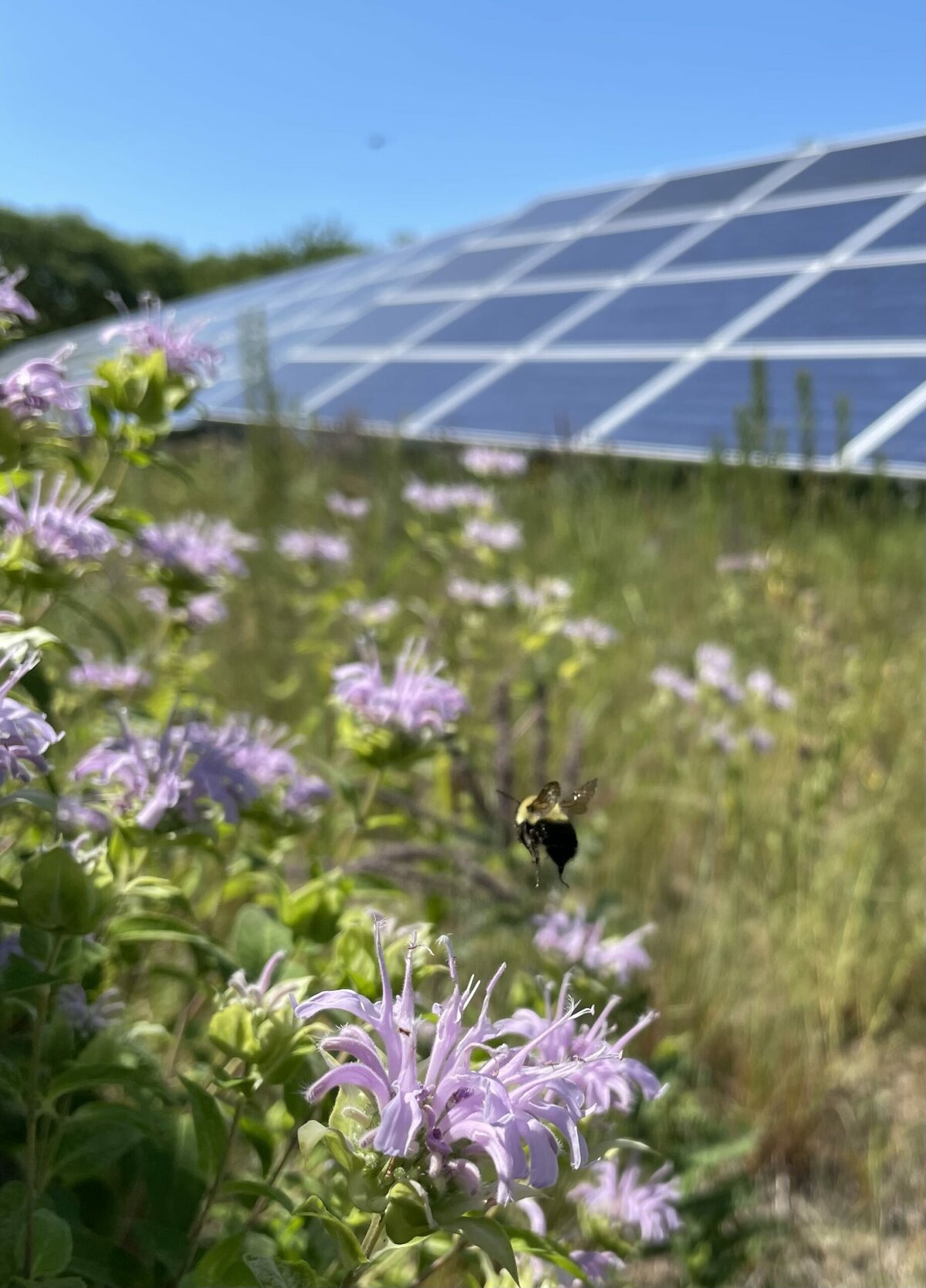Amid black-eyed Susans and purple wildflowers growing between rows of solar panels at Connexus Energy’s headquarters in Ramsey, Minnesota, Rob Davis has seen hover flies, swallows and a hummingbird moth.
“It’s just like being in a nice, natural place,” says Davis, Connexus public affairs lead. “But it’s also just a visual delight, because there’s so many things to see when you sit and wait.”
When the array was installed almost a decade ago, the initial plan was to keep gravel around the panels. Instead, the electricity co-op planted a mixture of flowering plants — becoming what Davis says was the first pollinator-friendly solar project in the US.

Now, many others are following suit.
In Minnesota and across the country, planners are increasingly eschewing turf grass and gravel for flowering meadows that support butterflies, bees, insects and other threatened wildlife.
“You have the opportunity with solar to actually benefit the surrounding land if you’re thoughtful about how you do it,” says Katie Siegner, a manager in carbon-free electricity at RMI who has researched pollinator-friendly solar.
Bees, bats, insects and birds that help to pollinate plants are responsible for a key part of the ecosystem, and are crucial for growing food. But they are struggling, due in part to climate change, habitat loss and use of pesticides and herbicides. The western bumblebee population has declined by 57% since 1998. Migratory monarch butterflies were listed as an endangered species by the International Union for Conservation of Nature last year, with the population estimated to have diminished by between 22% and 72% in the last decade. Honey bee colonies have declined by up to a third every winter in recent years, according to the US Department of Agriculture.
Meanwhile, as the Biden administration has sought to scale up solar energy, panels are poised to take up more space on the landscape. Advocates focused on pollinators see potential benefits in the solar fields, compared to other types of land use.
“It provides a pretty incredible opportunity,” says Wendy Caldwell, executive director of the nonprofit Monarch Joint Venture, which aims to conserve habitat for monarch butterflies and other pollinators.
Since the monarch first was reviewed for endangered species status in the US in 2014 conservationists adopted an all-hands-on-deck approach to try to expand habitat, Caldwell says, looking to buffer zones on agricultural lands, roadsides, urban gardens and more. Solar developments have an additional benefit of not needing the pesticides and herbicides common to farming, she says.
In a study of four solar installations with flowering ground cover, which included milkweed, in Minnesota, Monarch Joint Venture found that a variety of species — including monarchs — were present.
Crushed by negative news?
Sign up for the Reasons to be Cheerful newsletter.“We know that monarchs and other pollinators are using these sites,” Caldwell says.
In the UK, researchers found “solar meadows” could boost the number of bumblebees even in nearby areas. Shade from the panels can delay the flowering of some plants, giving pollinators access to pollen later in the season. A 2021 report in Environmental Entomology concluded that native flowering species suited to the site around solar developments could support pollinators, though it underscored the importance of implementing projects carefully, having oversight and assessing how well they are growing.
At the Ramsey array, a Connexus team walks the site once a year, clearing out baby trees growing as weeds, according to Davis. Every other year, the field is mulch mowed, which breaks up the dead plant material that settles. Some projects use occasional sheep grazing for a similar effect. Aside from occasional spot reseeding, Davis says the project takes very little ongoing maintenance. Connexus now uses pollinator-friendly habitat in all of its projects. Some projects involve beekeepers, producing honey that can be sold.
Minnesota was the first state to establish a scorecard for pollinator-friendly solar projects, passing legislation in 2016. Sites use the guide to log everything from the diversity of plantings to percentage of wildflower cover.
“The movement shifted to thinking about the entire landscape instead of just a superficial fringe,” Davis says.
As of March 2022, 55 Minnesota solar sites were listed as pollinator friendly. More than a dozen other states now have similar scorecards.

Siegner, of RMI, found in her research that pollinator habitat brings other benefits to solar sites. The planted meadows sequester carbon, help recharge groundwater and reduce erosion. Improving habitat for bees and insects could also boost yields for crops that depend on pollinators at neighboring farms; a model found soy yields could be up by 6.3 percent near pollinator-friendly solar.
Siegner says incorporating pollinator habitat can win local support for solar projects — a hurdle for many solar developers. Finding dual uses, like grazing sheep or incorporating other types of agriculture, is one strategy for courting local acceptance.
Plantings for a pollinator-friendly solar project can cost more than turf or gravel, and finding a sufficient supply of native seeds can also be a challenge. But the Bee and Butterfly Habitat Fund’s Solar Synergy initiative, launched in March, will soon provide solar developers with free seed mixtures suited to specific site needs that will flower from early spring through the summer. One seed mix will be low growing, featuring plants like clover, that won’t impede panels close to the ground. Another taller mixture will be suitable for buffer areas. Monarch Joint Venture is on board to monitor sites and report on how well the habitats work for pollinators. Bee and Butterfly Habitat Fund will also connect project leaders with commercial beekeepers, so the arrays can be used to produce honey.
“It’s another way of delivering multiple benefits,” says Pete Berthelsen, Bee and Butterfly Habitat Fund executive director. “I really like the fact that it’s green renewable energy, and we’re putting less carbon into the atmosphere because of it. But who wouldn’t want there to be pollinator benefits associated with that project going in?”








